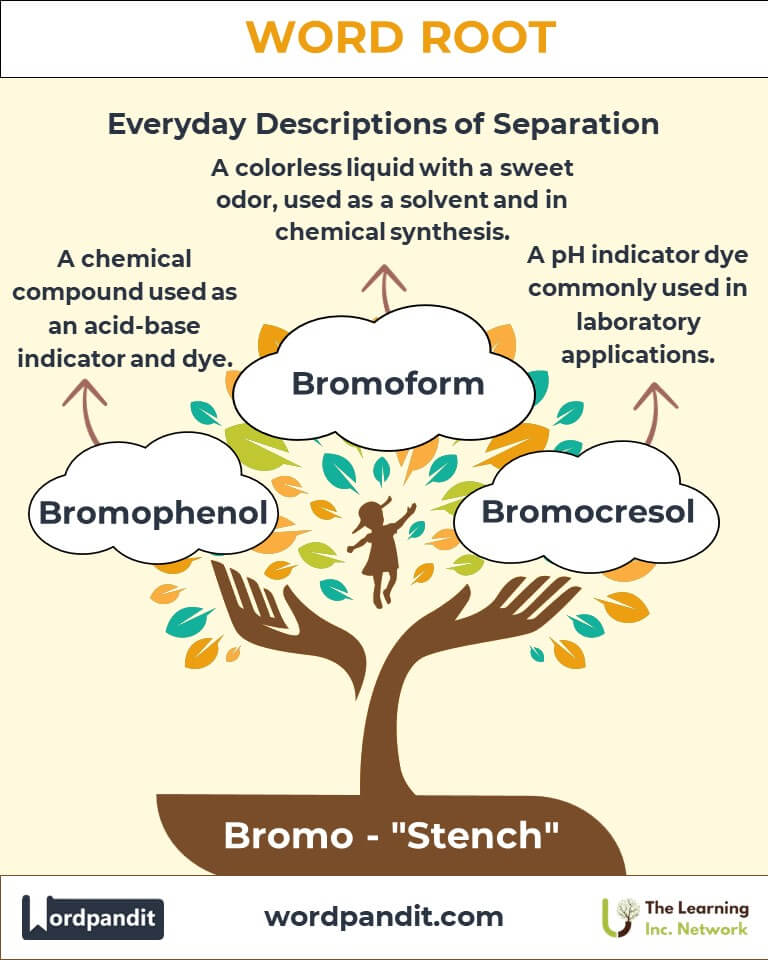Bromo: The Root of Stench and Tranquility Across Language and Chemistry
Discover the multifaceted nature of the root "Bromo", derived from the Greek word bromos, meaning stench. This root permeates the realms of language, science, and even culture, embodying diverse connotations from unpleasant odors to tranquilizing compounds. Join us on a journey to explore the impact of "Bromo" in words, chemistry, and society.

Table of Contents
- Introduction: The Dual Essence of "Bromo"
- Etymology and Historical Journey
- Mnemonic: Unlocking the Power of "Bromo"
- Common Bromo-Related Terms
- Bromo Through Time
- Bromo in Specialized Fields
- Illustrative Story: "Bromo" in Action
- Cultural Significance of the Bromo Root
- The Bromo Family Tree
- FAQs about the Bromo Word Root
- Test Your Knowledge: Bromo Mastery Quiz
- Conclusion: The Lasting Legacy of "Bromo"
Introduction: The Dual Essence of "Bromo"
The word root "Bromo" may evoke contrasting images: the pungent stench of unpleasant smells and the calming effects of chemical compounds. Originating from the Greek bromos (stench), this root has found a unique place in both language and chemistry. From bromine, a pungent chemical element, to bromide, a term symbolizing both tranquilizers and clichés, "Bromo" exemplifies its rich and complex duality.
Etymology and Historical Journey
The root "Bromo" comes from the Greek βρῶμος (bromos), meaning stench or smell. Early Greeks associated it with odors, especially strong or unpleasant ones. The term gained prominence in the 19th century with the discovery of bromine, a volatile and smelly halogen. Its usage expanded in chemistry, influencing terms like bromides, which transitioned from describing sedatives to idiomatic expressions for tired clichés.
Mnemonic: Unlocking the Power of "Bromo"
To remember "Bromo," imagine a scientist holding a vial of bromine. The room fills with an overpowering stench, but the scientist uses a bromide compound to calm themselves and neutralize the chaos.
Mnemonic Device:
"Bromo brings the stench, but bromides bring the calm."
Common Bromo-Related Terms
- Bromine (BROH-meen): A smelly, reddish-brown chemical element used in dyes and flame retardants.
Example: "Bromine is essential in the production of certain fire-resistant materials." - Bromide (BROH-mide): Originally a sedative compound; now refers to a trite or overused idea.
Example: "His advice to 'follow your dreams' felt like a bromide, lacking real insight." - Bromism (BROH-miz-um): A medical condition caused by excessive bromide intake, leading to drowsiness and confusion.
Example: "Prolonged use of sedatives resulted in bromism symptoms." - Bromate (BROH-mate): A compound containing bromine, often used in water treatment and food processing.
Example: "Bromates are regulated in drinking water due to health concerns." - Bromophobia (broh-MOH-foh-bee-uh): An irrational fear of bad smells.
Example: "Her bromophobia made her avoid crowded spaces."
Bromo Through Time
- Ancient Greece: "Bromos" was associated with foul smells and metaphorically with unpleasant events.
- 19th Century Chemistry: The isolation of bromine highlighted its strong odor, cementing its connection to the root’s meaning.
- Modern Idiom: "Bromide" transitioned from chemical terminology to idiomatic use, symbolizing overused expressions.
Bromo in Specialized Fields
- Chemistry: Bromine plays a vital role in flame retardants, pesticides, and pharmaceuticals. Bromides were historically used as sedatives and anticonvulsants.
- Medicine: Bromism sheds light on the effects of overusing bromide-containing medications.
- Linguistics: The idiomatic use of bromide reflects societal attitudes toward clichés and originality.
Illustrative Story: "Bromo" in Action
Dr. Elena, a chemist, worked tirelessly in her lab, researching bromine’s potential as an eco-friendly pesticide. The pungent smell of bromine filled the air, reminding her of its Greek origins. One evening, as she struggled with exhaustion, her colleague offered a bromide pill to calm her nerves. That moment bridged the root’s historical and practical significance, as science and language intertwined in her journey.
Cultural Significance of the Bromo Root
"Bromo" encapsulates contrasting human experiences: repulsion and relief. It symbolizes the balance between chaos (stench) and order (tranquility). This duality appears in idioms, medicine, and even environmental debates, showcasing its lasting cultural resonance.
The Bromo Family Tree
- Odor (Latin: "smell"): Examples: Malodor (unpleasant smell), Deodorize (to remove odors).
- Halogen Roots: Examples: Chlorine (Cl) and Fluorine (F), both related to pungent characteristics.
- Tranquil Roots: Sed (Latin: "calm") — Examples: Sedative, Sedation.
FAQs About the Bromo Root
Q: What does "Bromo" mean?
A: The root "Bromo" originates from the Greek word bromos, meaning stench or bad smell. Over time, it has been associated with the chemical element bromine, known for its strong, unpleasant odor, as well as with terms like bromide, which has taken on both chemical and metaphorical meanings.
Q: What is bromide used for today?
A: Bromide compounds are still used in specialized areas such as:
- Photography: In silver bromide emulsions for traditional photographic films.
- Medicine: Historically used as sedatives and anticonvulsants, although less common now.
- Idiomatic language: To describe overused or trite ideas (e.g., "That’s just a bromide!").
Q: Why does bromine smell so strong?
A: Bromine is highly volatile and reactive, releasing fumes easily into the air. These fumes interact with our olfactory receptors in a way that produces an intense, unpleasant smell.
Q: Is bromine harmful to humans?
A: Yes, bromine can be harmful if inhaled or ingested in large quantities. Its strong fumes can irritate the respiratory system and skin, and prolonged exposure may cause serious health issues.
Q: How did bromide become an idiom for clichés?
A: In the 19th century, bromides were used as calming agents or sedatives. Over time, the idea of calming or dulling someone metaphorically extended to describe uninspiring, overused ideas that might "soothe" but lack originality.
Q: What is bromism?
A: Bromism is a condition caused by the prolonged or excessive use of bromide compounds. Symptoms include drowsiness, mental confusion, and other neurological impairments due to bromide accumulation in the body.
Q: What is bromophobia?
A: Bromophobia is an irrational fear of bad smells. While not a medically recognized condition, it reflects the aversion some people have toward strong, unpleasant odors.
Q: Why is bromine important in chemistry?
A: Bromine is vital for producing:
- Flame retardants: Reducing the flammability of materials.
- Dyes and pesticides: Found in certain agricultural and textile industries.
- Pharmaceuticals: As a reagent in the synthesis of some medicines.
Test Your Knowledge: Bromo Mastery Quiz
1. What does the root "Bromo" signify?
2. What is bromide used for idiomatically?
3. What condition results from excess bromide use?
4. Which halogen is known for its stench?
5. What does bromophobia describe?
Conclusion: The Lasting Legacy of "Bromo"
The root "Bromo" bridges the sensory world of smells and the intellectual realms of chemistry and language. From its Greek origins to its modern applications, it demonstrates the interplay between perception and innovation. As "Bromo" continues to evolve, its duality reminds us of life’s balance between chaos and calm—a legacy rooted in both history and science.













